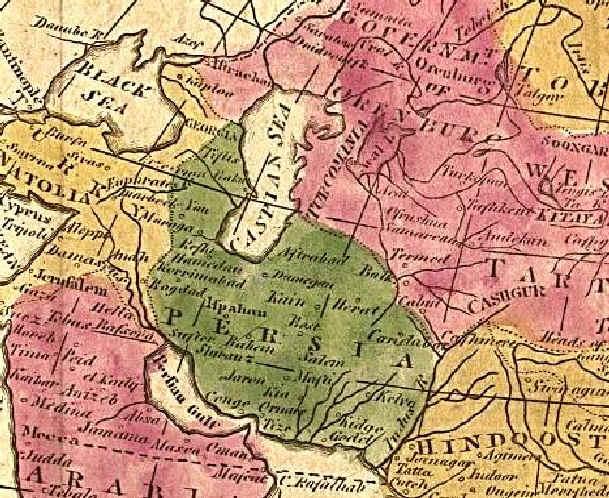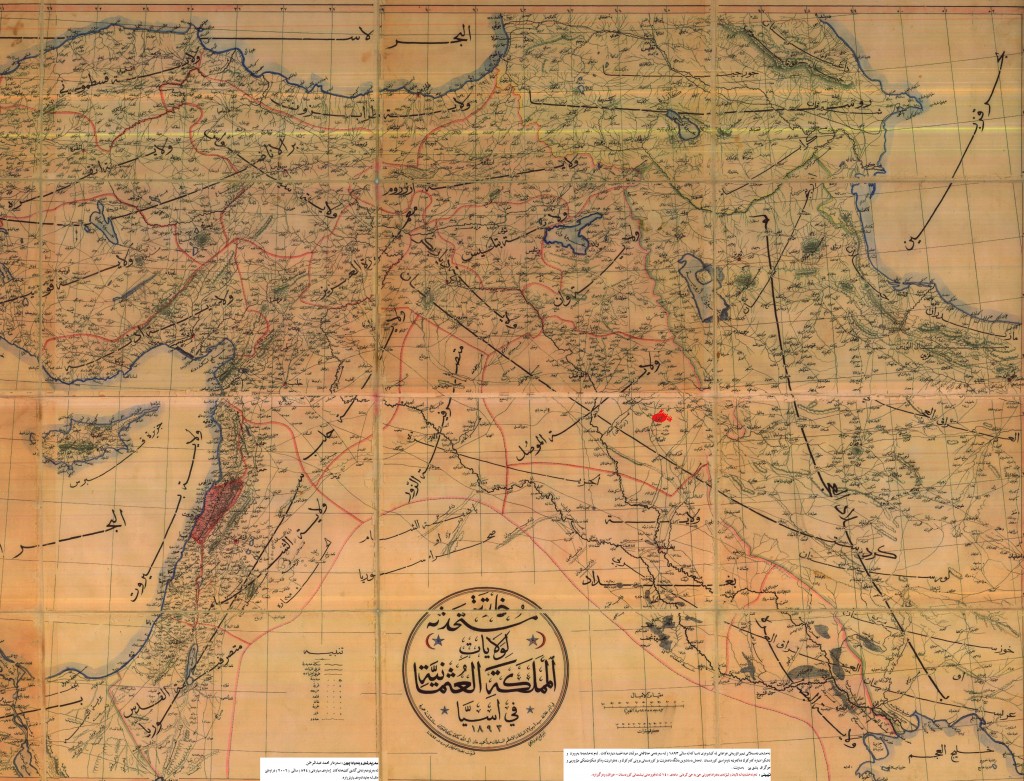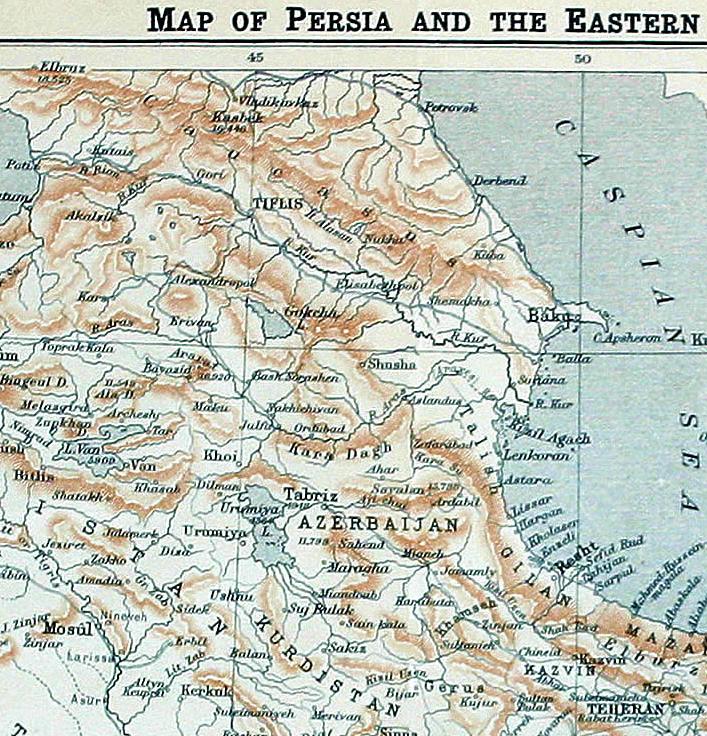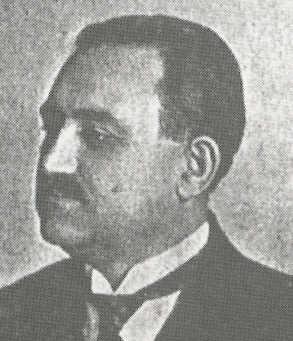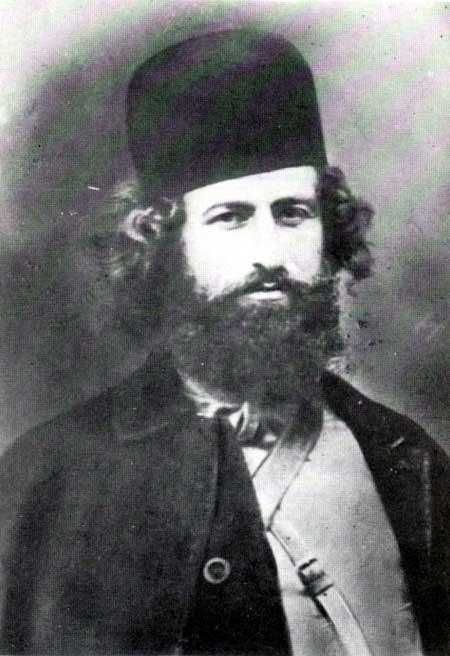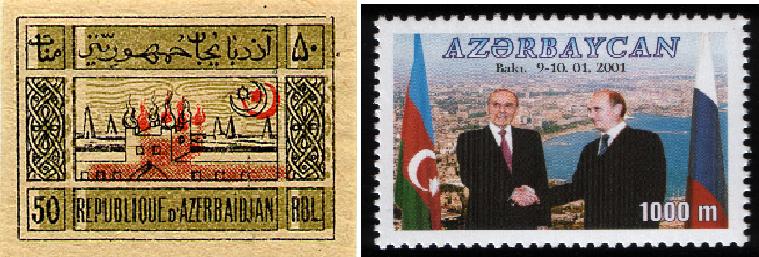Yusef Amiri: Explore the myth of a “North Azarbaijan” and “South Azarbaijan”. How and When did this terminology first originate?
– افسانهی آذربایجان شمالی و جنوبی را بیشتر بشکافید. از چه زمانی این اصطلاح رایج شد؟
Kaveh Farrokh: This is a clear fabrication indebted to the Communist regime of Joseph Stalin and his liaisons in Baku. But before we discuss this in detail let us have a quick study of the historical references.
The book Golestan-e-Aram written by Abbas-Gholi Agha Bakikhanov in the 19th century in Transcaucasia clearly reports the historical Azarbaijan as being south of the Araxes river inside Iran; this being totally distinct from Shirvan and Arran. The Golestan-e-Aram was also known as the history of Shirvan and Darband. It is also noteworthy that Bakikhanov was from Baku. He was one of the first non-European historians of the Transcaucasus who was trained in European methods of historiography and analysis – his book is in essence a product of this system of education.
But what do western sources state during the early 20th century? One solid source is the 1911 edition of the Encyclopedia Britannica which clearly states that the historical Azerbaijan in Iran is:
“…the north-western and. most important province of Persia…It is separated from Russian territory on the N. by the river Aras
[Araxes]”.Notice that there is no mention in the above definition of a “Russian Azarbaijan” or a “North Azarbaijan”.
Map of Iran in 1805 before the invasions of Czarist Russia. Note the Caucasus, north of Iran and along the eastern Caspian littoral, which was Iranian territory. There was no “Greater Azerbaijan” supposedly “divided” between Iran and Russia. Russia invaded Iran and forced her to cede the Caucasus. Iran also lost important eastern territories such as Herat, which broke away with British support, Picture source from CAIS.
The Russian language “Russian Encyclopedia” which had been printed in 1890 in St. Petersburg, Imperial Russia as well as Leipzig, Imperial Germany clearly distinguished Albania/Arran from Azerbaijan in Iran (readers may want to see discussion by Matini, 1989, p.455).
More historical archives may be produced to dismiss the “North” versus “South” propaganda narrative. Below is an Ottoman map drafted in 1893:
Ottoman map [Click to Enlarge] outlining Western Iran and the Caucasus in 1893. Note that Azarbaijan is clearly shown to be the land below or to the south of Aras (Araxes) river – the territories corresponding to the present Republic of Azarbaijan were not known as “Azarbaijan”, but variously as the Caucasian khantes (i.e. Baku, Sheki, Nakhchevan, etc.) or as “Albania” or “Arran”.
After a thorough study of Soviet and Russian archives Zenkovsky concluded that prior to the rise of the Baku Musavats in 1918:
“Azarbaijani [in reference to modern Republic of Azarbaijan and not Azarbaijan in Iran] territory never formed a separate, united state, and even under Persian domination eastern Transcaucasia was divided into a multitude of loosely connected feudal principalities”. The very term ‘Azarbaijan’ was rarely applied before 1917 to the Elizavetopol [Ganja] and Baku provinces which later formed the Azarbaijani Republic, this term being commonly used only for the Persian provinces bordering Russian Transcaucasia” (see Zenkovsky, 1960, p.274).
A portion of a large British Map of 1909 (by Sesley and Company Ltd.). Note that Azarbaijan is clearly identified inside Iranian territory below the Araxes River. The territory `to the north and northeast of the Araxes River, now known as the “Republic of Azarbaijan” is not identified on the above map as “Azarbaijan”.
This quick study of three Tsarist-era references and Zenkowsky solidly affirms the fact that Azerbaijan in Iran was historically differentiated from the modern-day ROA (Albania/Arran) during the Czarist dynasty. Later in the interview when we discuss the role of Baku in the promotion of historical revisionism, We will look at more historical maps and references that prove that Azarbaijan only existed in Iran – that is, south of the Araxes river.
It is also highly significant that the term “Azarbaijani” was not used in reference to the Turkic-speakers of the Caucasus. This is corroborated by none other than Joseph Stalin himself, who during his tenure as the chief Communist authority on Russia’s nationalities in Russia, described the peoples of the Caucasus and the south Russian steppes in 1913 as “…Tatars…Armenians, Georgians and Ukrainians…” (see Joseph Stalin, 1913 [English translation 1942], p.3). There is no mention of “Azarbaijanis” when referring to Caucasian Turkic-speakers within the Russian empire. Another example is seen in a British official representing petroleum interests in 1905 – he too referred to the Turkic-speakers of the Caucasus as “Tatars” in 1905 (see Croissant, 1998, p.90) – again, no reference to “Azarbaijanis” in Russia.
The fact that we refer to the peoples of the former regions of Arran-Albania today as “Azarbaijanis” shows how successful Russian, Soviet and pan-Turk propaganda has been in social engineering and the re-writing of history. Falsified history and manufactured “national” continue to influence the nation-state of the Republic of Azarbaijan.
So how did the false myth of a “North and South Azarbaijan” begin?
Recall that the Musavat Party of Baku had basically taken the name of an Iranian province, Azarbaijan, and applied it to the southeastern khanates of the Caucasus in May 1918. From the outset, the objective of “borrowing” Azarbaijan’s name for the region was geopolitical. The illusion of a historically non-existent “Greater Azarbaijan” divided by Iran and Russia had been created from the outset.
It was very easy for the Musavats to create such a gross historical fabrication. After all, the majority of Arranis (or Albanians) and Azerbaijanis speak Azari-Turkic and have family ties in both regions. The Musavat of course were silent as to why these ties in language and family existed in the first place. The ties were there becuase the Caucasian Khanates had been Iranian territory until their forcible conquests by the Russians. Peoples in Iran’s provinces often migrate and intermarry their fellow citizens in neighboring provinces over time – the same process which took place between Azarbaijan and Arran-Albania (or the Khanates) provinces. The same process happens within the provinces of other sovereign countries.
A leading proponent of the Caucasian khanate’s name change to “Azerbaijan” was Mohammad Amin Rasulzadeh (1884-1955), the first leader of the newly created Republic of Azerbaijan (see photo below). Rasulzadeh was of Iranian origin from Baku, and was in fact heavily involved in the constitutional democratic movement of Iran during the early 1900s (Chaqueri, Cosroe, Origins of Social Democracy in Iran, 2001, p.118, 174-181, 209-210).
Mohammad Amin Rasulzadeh (1884-1955) became the first leader of the newly created Republic of Azarbaijan.
Rasulzadeh was in fact the editor of the newspaper Iran-e-Now (The New Iran). Russian influence and coercion finally forced the Iranian government to expel Rasulzadeh from Iran in 1909 (?); he was exiled to Ottoman Turkey, where the Young Turk movement had gained power.
The Young Turk movement had a profound psychological influence on Rasulzadeh; he became ensnared in the embrace of pan-Turanianism. It is noteworthy that before his conversion to pan-Turaniasm, Rasulzadeh viewed himself and his native Arran (Albania) in his writings as members of “Our beloved homeland Iran…” (Rasulzadeh, Mohammad Amin, 1910, Tanqid-e Ferqeh-e E’tedaliyun ya Ejtema’iyun E’tedaliyun, Tehran, Farus. See also citation by Atabaki, Touraj, Azerbaijan: Ethnicity and the Struggle for Power in Iran, 2000, p.38).
By 1913, the pan-Turkicized Rasulzadeh returned to the Caucasus where he joined the Musavat Party and quickly rose within its rnaks to assume its leadership.
Iranians in general and Azarbaijani activists in particular, opposed the new name for Arran (Albania). Iranian Azerbaijani political activist Shaikh Mohammad Khiyabani (1880–1920). Khiyabani had been active in the Iranian Constitutional revolution and had been an important figure in the Iranian parliament.
Shaikh Mohammad Khiyabani (1880–1920) of Iranian Azarbaijan opposed theMusavats of Baku and their adoption of the name “Azerbaijan” for the Caucasian Khanates. In protest and in an endeavor to distinguish the historical (Iranian) Azarbaijan from the Musavat entity, Khiyabani prpopsed that the name of Iran’s Azarbaijan province be changed to “Azadistan” (land of Freedom). Khiyabani repeatedly reported to British officials that he believed in a united Iran. Khiyabani also opposed the occupation of Iranian Azarbaijan by the Ottoman Turks in 1918 – Khiyabani was jailed by the Ottoman Turks. All of these documented facts are misrepresented in the Republic of Azerbaijan which publishes a falsified version of history in an attempt to re-case Khiyabani as an anti-Persian separatist.
Rasulzadeh later admitted in 1924 to his former Iranian comrade, Sheikh Hassan Taqhizadeh of Tabriz that he wished to do
“…whatever is in his power to avoid any further discontent among Iranians” (Blucher, W.V., Zeitenwende, Persian Translation: Safar-nameh-e-Blucher, Tehran, Khwarami, 1984, p.37. Tancoigne, A Narrative, p.177. See Ayandeh (1988), vol 4, no.s 1-2, p. 57-59)).
Rasulzadeh also admitted that:
“…Albania (present Republic of Azerbaijan) is different from Azerbaijan (the original Azerbaijan in Iran)” (Ramazani, R., op. cit. p.115. See also citation by Atabaki, Touraj, Azerbaijan: Ethnicity and the Struggle for Power in Iran, 2000, p.25).
Despite these admissions, rasulzadeh had by the 1930s been completley ensnared by the 1930s, fallen victim to pan-Turkist ideology. His writings reveal his full transformation to historical revisionism. Rasulzadeh:
(a) first admitted that “Azerbaijan” (Arran and Azarbaijan in Iran?) was an ancient Iranian province that had been linguistically Turcified since at least the 13th century.
(b) then rejected his previous writings by declaring that “Azerbaijan” (both Arran and Azarbaijan in Iran) had always been “Turkish” and was never historically an integral part of Iran (Chaqeri, Origins of Social Democracy in Iran, p.209; Watson, A History, p.26; Bassett, The Land of Imams, p.266; US Consular Report, p.294)
Mirza Kuchek Khan (1880-1921) a north Iranian (Gilani) activist who fought for years against foreign occupiers of Iranian territory. Like Khiyabani in Iranian Azarbaijan, Mirza Kuchek Khan was opposed to the usage of the term “Azerbaijan” for Arran and the Caucasian Khanates by the Baku Musavats.
It is also important to note that to this day a vast proportion of the citizens of Arran-Albania are Shiites, due to the fact that their region was part of the Iranian state until their detachment by the Russians. The Musavat completely ignored these facts in their political and educational discourse.
As noted already, pan-Turk activists first applied the name of Iran’s Azerbaijan province to another former Iranian province (Arran) and then proposed to annex the real Azarbaijan (in Iran) into their newly born republic (see Matini, 1989, p.452). Zarewand writing in 1926 duly took note of this by noting that:
“The northern (Russian) Azarbaijanis consider southwestern (Iranian) Azarbaijan as an integral part of future Greater Azarbaijan. This is why they have adopted the ethnic name Azari and the land-name Azarbaijan which originally and exclusively belonged to the northeastern area of Iran around Tabriz and the lake of Urmia” (see Zarewand, 1926, p.144).
What is remarkable is how quickly the pan-Turk ideologues of the Musavats began to believe their own propaganda as historical fact. One example is Nasib Bey Ussubekov (a Musavat activist and one of the leaders of the republic in 1918) who made it clear that he regarded Iranian Azerbaijan as a part of the newly invented “Independent Republic of Azerbaijan”.
This historical falsification can be seen in stmaps printed in the Republic in 1919 – ironically, despite massive Russian anti-Persian social engineering efforts, the stmaps still use the Perso-Arabic script as shown below:
Left: Stamp issued by the newly-created Republic of Azarbaijan in the Caucasus (known as Arran and the Caucasian Khanates until 1918). Note that this stmap evne features a Zoroastrian fire temple. Right: A large portrait of the stamp of the Republic in 2001 – the late Haydar Aliev (1923-2003) and Vladimir Putin pose for an official photo. Note that all traces of Arabo-Persian script and the ancient Zoroastrian Fire-Temple have been removed in the 2001 version in favor of Euro-Latin derived script. As noted in the discussion on Czarist Russian socio-cultural engineering, much effort was expended since the 19th century to eliminate the Caucasus’ Persian language and cultural legacy. Note that both Putin and Aliev were propaganda officers with the KGB in the former Soviet Union.
It would be up to the succeeding Soviets of Moscow and Baku to refine the “Greater Azarbaijan” thesis into the terms “North” and “South” Azarbaijan (Matini, Jalal, “Azarbaijan Koja Ast?”, 1989, Iranshenasi, I(3), p.449). Historian Nazrin Mehdiyova, who is from the Republic of Azarbaijan herself, corroborates this by affirming that:
“…the myth [of a North versus South Azerbaijan] was invented under the Soviets for the purpose of breaking Azerbaijan’s historical links with Iran. To make this historical revisionism more acceptable, the Soviet authorities falsified documents and re-wrote history books. “
Professor Mehdiyova makes a very important point. The Soviets retained the pan-Turkist invention for Arran and the Kahnates. these were now known as “The Soviet Republic of Azerbaijan”. A quick study of rare historical archives reveals a very cynically self-serving Soviet approach to this affair:
“The name “Azerbaijan” for the Republic of Azerbaijan (Soviet Azerbaijan) was selected on the assumption that the stationing of such as republic would lead to that entity Iranian to become one…this is the reason why the name “Azerbaijan” was selected (for Arran)…anytime when it is necessary to select a name that refers to the territory of the Republic of Azerbaijan, we should/can select the name Arran…” (Bartold, 1963, p.217)
This was a brilliant geopolitical move, as it now allowed for Russia, like the Ottoman Turks before them, to eventually make a grab for Iranian Azarbaijan. Joseph (Iosef) Stalin (born Djugashvilii – his mother was Ossetian) one of the key historical leaders of the Soviet Union, played a key role in falsifying history to promote imperialism.
Joseph Stalin (1878-1953). Stalin and his writers intentionally re-wrote history to erase all mention of the Caucasus’ cultural and historical associations with Iran. Stalin deliberately and repeatedly referred to many famous Iranian literary figures (such as Nizami, Ganji, Shabestari, etc.) as “great national Azerbaijani literary figures“.
Soviet Russia was essentially the same as Czarist Russia – both were imperialist and both promoted racist Persophobia. The Soviets worked hard to promote Persophobic sentiments in the mainly non-European colonies they had conquered in the Caucasus and Central Aisa. Interestingly, these de-Iranization or Persophobic policies were often harmonious with pan-Turkism.
A recent book published in Baku about Mohammad Amin Rasulzadeh and his conflicts with Joseph Stalin. The title of the book is deceptive as it implies that Stalin attempted to “suppress” the region’s ethnic identity, when in fact the oppostie is true. First, as noted in this article, Stalin funnelled many resources into ethno-engineering the Trans-Caucasus (regions known today as the Republic of Azarbaijan) and continued the nation-building policies of Rasulzadeh and the pan-Turkist Musavat party. Second, Stalin was eager to recruit Rasulzadeh into the Soviet order, but the latter refused. Stalin’s arrival into the region was simply a “change in management” – Persophic policies continued with no interruption, right up to and after the fall of the Soviet Union in the early 1990s.
The Soviet Union went to great pains to extinguish the Persian cultural legacy by selectively promoting pan-Turkism. Recently two articles were posted by Tajikestanweb, namely The Axed Persian Identity Part I (see Persian translation in Shahrbaraz Blog, The Axed Persian Identity Part II and The Axed Persian Identity Part III. These essays provide a number of interesting academic and well-researched references that expose the former Soviet regime’s attempts in de-Iranianizing Central Asia, in this case Tajikestan. The article notes that:
But it should be mentioned here that Tajiks, who had no allies in the new Slavo-Turkic union, were among the main victims of the Soviet population counts and their number decreased drastically between 1917 and 1926 censuses. The chief secretary of the Tajik Committee of the Uzbek Communist Party at the time believed that the ‘biased and unfair’ 1926 census was a tool of Uzbekization. As a result, millions of Tajiks in Samarkand, Bukhara, Surkhan-Darya and other Persian-populated areas of Uzbekistan turned into Uzbeks overnight.
Recall that the policy of promoting pan-Turkism to destroy the Persian historical and linguistic legacy dates back to the Czarist era, in fact as far back as the 1830s, right after the conclusion of the disastrous Russo-Iranian war in which Iran was forced to cede her possessions in the Caucasus (everything above the Araxes River just above the Iranian province of Azarbaijan) to Russia.
By the time Russian tanks had rolled into Iran in August 1941, the North-South myth had already become a mainstay of Soviet propaganda and written into Communist history books. It is an unfortunate fact that this same Soviet propaganda literature is now being rehabilitated by many western academic circles with ties to commercial interests.

